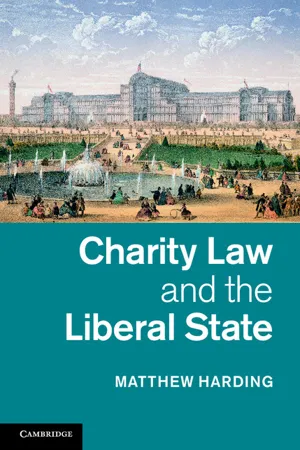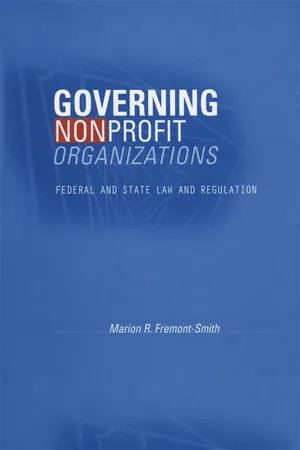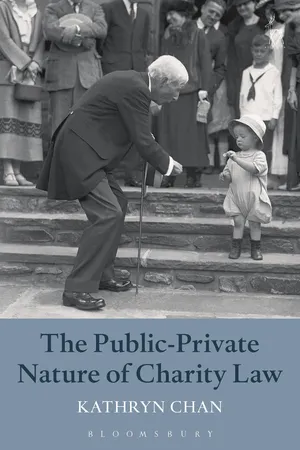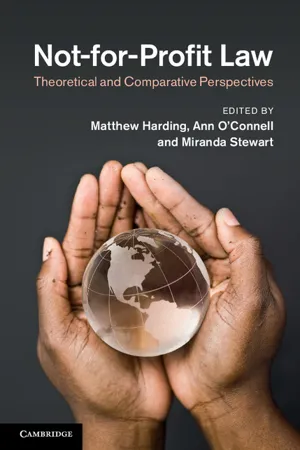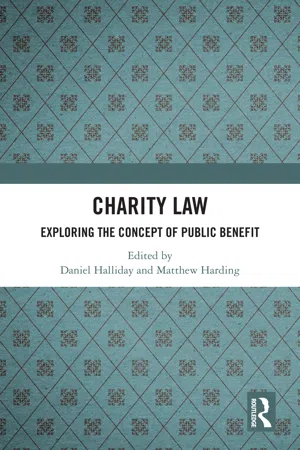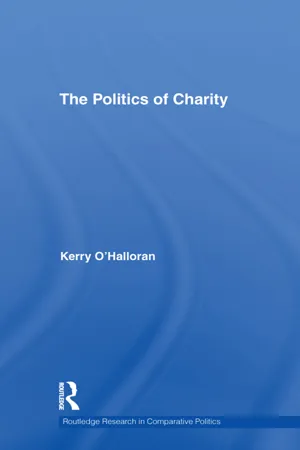Law
Charity Law
Charity law refers to the legal framework that governs the establishment, operation, and regulation of charitable organizations. It encompasses rules related to charitable purposes, tax exemptions, fundraising activities, governance, and accountability. Charity law aims to ensure that charitable entities operate in the public interest and comply with legal requirements to maintain public trust and confidence.
Written by Perlego with AI-assistance
Related key terms
1 of 5
11 Key excerpts on "Charity Law"
- eBook - PDF
- Matthew Harding(Author)
- 2014(Publication Date)
- Cambridge University Press(Publisher)
1 Charity Law in overview 1. Introduction As we saw in the Introduction, this book will address questions about state action and public discourse that are raised by Charity Law. In order to set the stage for such inquiries, we should begin by looking at our subject in overview, seeking to identify key features that tend to characterise Charity Law wherever it is found, and in light of which questions about state action and public discourse may be framed. That is the aim of this chapter. When looked at in overview, Charity Law may be divided into two broad parts: that which addresses the ques- tion whether or not a purpose is charitable in law 1 and that which addresses the question of what legal consequences flow from the pursuit of charitable purposes. The first part of Charity Law itself breaks down into two further components: the first of these further components consists of a set of criteria by which decision-makers determine the charitable or non-charitable character of purposes and the second consists of a number of rules according to which certain purposes are disqualified from being charitable. The second broad part of Charity Law consists of rules spelling out the legal consequences for those who carry out charitable purposes; the most significant of those consequences – at least in the context of a study of Charity Law and the liberal state – are the legal privileges that Charity Law extends to those with charitable purposes. With these preliminary taxonomical obser- vations in mind, our overview of Charity Law in this chapter will begin with an examination of the criteria of Charity Law; we will then turn to 1 In most jurisdictions, Charity Law takes an interest in the character of purposes, rather than in the activities that are carried out in the pursuit of purposes. The boundary between purposes and activities is not always kept distinct, however, and in Scotland, Charity Law takes an overt interest in activities. - eBook - ePub
Charity Law
International Perspectives
- Juliet Chevalier-Watts(Author)
- 2017(Publication Date)
- Routledge(Publisher)
1 An introduction to Charity LawThis chapter introduces some of the concepts of Charity Law, which will provide the context and parameters for the following chapters. The chapter illustrates many of the interconnections, as well as some key differences, of the jurisdictions that are the focus of this book. The jurisdictions in question are England and Wales, Canada, Australia, New Zealand, Singapore, and Hong Kong.A Introduction to Charity Law
Charity is an ancient concept, with its roots buried deeply in history. Charity is said to be a manifestation ‘of the better side of human nature’,1 and is ‘no doubt as old as mankind itself’.2 Undoubtedly charity means many things to many people, although in theory, its primary concern is alleviating poverty and the suffering of others. It may also provide and promote opportunities for others to better the human condition, as well as provide for social infrastructures for the well-being of communities. It even extends as far as pursuing aspects of religious worship. Nonetheless, while charity may have taken on many forms, legally speaking, it should be distinguished from benevolence and philanthropy. It has been argued that ‘benevolence’ should not be determined as being charitable at law because it has a ‘somewhat shadowy meaning’.3 Benevolent gifts have traditionally not been found charitable because they extend beyond that which is exclusively charitable.4 Indeed:5A gift simply to ‘benevolent purposes’ is objectionable: a benevolent purpose may be (but is not necessarily) charitable. The same is true of gifts to philanthropic purposes, utilitarian purposes, emigration, and public purposes: they all go further than legal charity. - eBook - PDF
Governing Nonprofit Organizations
Federal and State Law and Regulation
- Marion R. Fremont-Smith, Marion R Fremont-Smith(Authors)
- 2009(Publication Date)
- Belknap Press(Publisher)
2 A Brief History of the Law of Charities This chapter provides an overview of the origins of the laws that govern the creation, administration, and regulation of charities, tracing their develop-ment from earliest times to the present. Succeeding chapters contain detailed descriptions of these laws and in certain instances additional historical back-ground necessary for an understanding of their source and impact. Introduction There is no clear-cut body of American law that can be called “the law of charity.” Relevant law is to be found in the first instance in the law of trusts, but it is also contained in the laws relating to corporations, state and federal tax laws, the law of decedents’ estates, and the entire field of property law. It was under the law of uses, the forerunner of the present law of trusts, how-ever, that the legal concept of charity originated, and a study of government regulation of charities must start with this branch of the law. Theoretically, the acquisition of legal status as a charity is not necessary in order to perform philanthropic works. However, organized charity has grown and developed because society has granted privileges not accorded to private enterprises to those institutions meeting certain requirements. The best known of these benefits is, of course, exemption from taxation; but equally important from an historical standpoint is the relation of certain rules of law limiting the right to hold private property. Thus charitable entities are granted existence in perpetuity, the right to accumulate income, and the priv-ilege of having their purposes revised if they become obsolete. The legal re-quirements for classification under law as a charity have developed through the centuries and are still in flux. Evolution of Charities in Early Society The emergence of charities as legal entities was closely tied to religious phi-losophy and the development of the concepts of wills, testamentary dis-19 - eBook - ePub
- Kathryn Chan(Author)
- 2016(Publication Date)
- Hart Publishing(Publisher)
The analytical hypothesis of this book is that we can regard the law of charities as a hybrid legal discipline in both a general or categorical sense, and in a context-specific or functional sense. The charitable trust is a public law–private law hybrid in the general sense that it represents the adaptation of a private law institution (the trust) to a variant which is more of a public law nature, in cases where there is deemed to be a public interest in, or public benefit arising from, the trust. Where that condition is satisfied, the settlor’s project is specially privileged—the conditions for the validity of the trust are loosened, and the project is generally permitted to endure forever, but on the other hand the donor’s project is specially regulated in ways more akin to how the projects of public authorities or actors are controlled by public law. The charitable corporation was historically also a public law–private law hybrid in this general sense, although, as we shall in Chapter 2, its constituent public law and private law elements were somewhat different. Within this framework of general hybridity, charities also function and are regulated as a public law–private law hybrid in a context-specific or functional sense. By this I mean that within particular regulatory contexts, both the conditions for obtaining charitable status and its attendant fiscal benefits, and the regulation of the conduct of charities and their trustees, are continually being adjusted in such a way as to maintain in a broad sense a functional equilibrium between individual project pursuit and collective project pursuit; that is to say, an equilibrium between the protection of the autonomy of property-owning individuals to control and direct their own wealth (and, by extension, the protection of the autonomy of the trustees appointed by those individuals), and the furtherance of competing public interests or visions of the good - eBook - PDF
Not-for-Profit Law
Theoretical and Comparative Perspectives
- Matthew Harding, Ann O'Connell, Miranda Stewart(Authors)
- 2014(Publication Date)
- Cambridge University Press(Publisher)
50 Lim Kien Thye, ‘Clearing the Charity Muddle – A Statutory Proposal’ (1984) 26 Malaya Law Review 133. 51 Committee of Inquiry into the Effect of Charity Law and Practice on Voluntary Organisa- tions, Charity Law and Voluntary Organisations (1976) (‘Goodman Report’); Commission on the Future of the Voluntary Sector, above, n. 28; Charity Law Reform Advisory Group (UK), For the Public Benefit?, above, n. 28. NCVO Charity Law Review Advisory Group, Final Report and Recommendations of NCVO’s Independent Review of the Charities Act 2006 (2012). 52 See, e.g., Michael Chesterman, Charities, Trusts and Social Welfare (Weidenfeld and Nicol- son, 1979). 188 joyce chia category should not be charities at all but we have come down on what we hope is the side of common sense in that anything that can effectively contribute to the cause of humanity without special advantage to any individuals is in general terms eligible for consideration as a charity. 53 This succinctly goes to the heart of the two distinct, although related, com- ponents of the legal definition of charity. At the core of our understanding of charity is the idea of the purpose of addressing disadvantage. Relieving poverty or sickness, promoting equality of participation and promoting international development all fall squarely into this hallowed core. How- ever, the legal definition of charity also encompasses other purposes that speak to the non-economic dimensions of what we might consider a ‘full life’, such as the arts, philosophy and religion. 54 Since we naturally differ on the elements required to sustain a ‘full life’, we naturally differ on the extent to which the legal definition of charity should encompass particu- lar purposes. The secular might not support tax concessions for religion, while those who dislike art might object to subsidising galleries. - eBook - ePub
Charity Law
Exploring the Concept of Public Benefit
- Daniel Halliday, Matthew Harding, Daniel Halliday, Matthew Harding(Authors)
- 2022(Publication Date)
- Routledge(Publisher)
Charities Act 2013 (Cth).15 For a recent instance of judicial notice being deployed in circumstances of apparent controversy, see Family First New Zealand v Attorney-General [2020] NZCA 366, where the Court took judicial notice that the majority of families in NZ are on the ‘traditional’ model (at [146]).16 See Jonathan Garton, Public Benefit in Charity Law (Oxford University Press 2013) for further discussion.17 This concern has been expressed most clearly in cases where purposes of political advocacy have been in view: see, e.g., Lord Parker in Bowman v Secular Society Ltd [1917] AC 406, 442.The importance of these questions, and of finding clearer answers to them in the law, cannot be overstated. Charity Law is sometimes thought of as a niche area, an outpost of Chancery jurisprudence dealing largely with the recognition and enforcement of testamentary trusts for purposes.18 If this was ever true of Charity Law – and there is ample reason to doubt that19 – it is certainly not true today. The field of application of Charity Law and its public benefit requirement has expanded over time, from trusts law to tax law and regulatory law as well.20 It stands today as a body of law regulating a large and diverse sector critical to social, economic, and political life. When the contribution of this charity sector, and the fiscal and other state preferments that support the sector, are fully measured and accounted for,21 the lesson is clear: Charity Law’s public benefit requirement is a central element in a fundamentally important body of law. Uncertainties and mysteries at the core of public benefit jurisprudence should not be tolerated any more than indeterminacy about the rules of marriage and divorce or the rules governing the operation of financial markets.18 - eBook - ePub
- Scott Atkins(Author)
- 2015(Publication Date)
- Routledge(Publisher)
15Chapter 15
Charities
This chapter considers an application of the law of trusts to a concept that has existed from at least the seventeenth century: charity. It is suggested that most people would believe that charities exist with the broadest purpose of doing good in society. This chapter looks at how charities exist in law and illustrates how charities in law are not limited to the everyday examples (such as the RSPCA or Cancer Research UK) with which you may be familiar.As You Read
Look out for the following key issues:- How charities are administered and the advantages of having charitable status; and
- The three essential requirements that an organisation must possess to be defined as a charity under the Charities Act 2011. These are that the organisation must:
- have a charitable purpose (as defined under section 3(1) of the Act);
- be shown to benefit the public (as required under section 2(1)(b) of the Act); and
- be wholly and exclusively charitable.
15.1 Background
The first example of Parliament recognising what was, at the time, a charity, was set out in the Preamble to the Statute of Charitable Uses 1601 (sometimes colloquially known as the ‘Statute of Elizabeth’). This Preamble contained a list of what was, in Elizabethan times, seen to be charitable although, as Lord Macnaghten pointed out in The Commissioners for Special Purposes of the Income Tax v Pemsel,1 the courts had recognised that charities could exist long before the 1601 Act. The courts used the Preamble to recognise those organisations or gifts as having charitable status if they fell within the list contained in it or fell within the ‘spirit and intendment’ of that list.Making Connections +++++++++++++++++You should remember from your studies of the English legal system that it is, of course, not usual for the Preamble of an Act to have such a prominent role as the one to the Statute of Charitable Uses 1601 enjoyed. The Preamble to an Act usually has no legal status and is usually an explanation of why the Act was enacted. But not only did the courts define whether an organisation or gift had charitable status by considering whether it fell within the definition in the Preamble, they also asked whether organisations or gifts of a similar nature to those set out in the Preamble could have charitable status. - eBook - ePub
- Mohamed Ramjohn(Author)
- 2014(Publication Date)
- Taylor & Francis(Publisher)
4 The Law of Charities INTRODUCTIONCharitable trusts are valid public purpose trusts. This means simply that it is perfectly possible to establish a trust for the achievement of a purpose, provided that the purpose in law is regarded as charitable. As far as charities are concerned, it is not important if there is no human beneficiary capable of enforcing the trust, because the Attorney General can take action in respect of all charitable trusts on behalf of the Crown. Moreover, valid charitable trusts are not subject to certain aspects of the perpetuity rule and may be of unlimited duration. Furthermore, when compared to valid private trusts (that is, trusts for human objects), charitable trusts have other advantages; they enjoy considerable fiscal privileges including exemption from many taxes. Hence, many of the decided cases involve HM Revenue & Customs seeking to deny charitable status. Likewise, there are special rules applicable to the failure of charitable trusts (the principles of cy-près) which may oust the normal rules of resulting trusts, and there is a separate body of rules dealing with the administration of charities and the conduct of business by charitable trustees.Obviously it is of singular importance to be able to distinguish between charitable purposes and non-charitable purposes. The former will be valid and enforceable, as well as having other advantages over private trusts, and the latter will be void unless they fall within one of the exceptions to the beneficiary principle considered in the previous chapter. TheCharities Act 2006enacted for the first time a statutory definition of charities after centuries of reliance mainly on case law to lead the way on the type of activities that would be given charitable status. The2006 Actintroduced a statutory definition by reference to a two-step approach – the listing of a variety of charitable purposes and the public benefit test. The2006 Acthas been repealed and replaced by theCharities Act 2011. This is a consolidating statute that repeals the diverse statutory provisions that are applicable to charities and insert the same in one statute. TheCharities Act 2011came into force on 14 March 2012. The2011 Act - eBook - ePub
- Mohamed Ramjohn(Author)
- 2013(Publication Date)
- Routledge(Publisher)
Charitable trustsLearning Outcomes
At the end of this chapter, you should be able to:- Identify the privileges that are available to charities
- Understand the requirement of public benefit
- Recognise charitable purposes within the Charities Act 2011
- Appreciate the need for the High Court to retain jurisdiction over charities with a foreign element
- Understand the cy-près doctrine
Introduction
The law of charities involves another form of express trust, namely a purpose trust for the benefit of the public but enforceable by the Attorney General. As a public trust, a number of privileges are enjoyed by such organisations.The law of charities has been a feature of the law of trusts for over four centuries, as evidenced by a wealth of case law. What constitutes a charitable purpose has now been enacted for the first time in the Charities Act 2006, which has been repealed and replaced by the Charities Act 2011. The definition incorporates a list of some 13 purposes as well as satisfying the public benefit requirement. Charities registered in the United Kingdom regularly conduct activities abroad and the legal issues raised by such activities involve the scope of the jurisdiction of the High Court. Finally, on the winding-up of a charitable body, the question of the destination of its funds will be considered under the cy-près doctrine.Privileges Enjoyed by Charitable Status
Charitable institutions have long been endowed with special privileges not accorded to private trusts. These privileges are recognition of the admirable work that is conducted by charities, and are in respect of (a) certainty of objects, (b) the perpetuity rule, (c) taxation and (d) the cy-près doctrine.- (a) Certainty of objects : Reference was made in Chapter 6 to the ‘beneficiary’ principle (i.e. the requirement that a beneficiary needs to have the capacity to enforce the trust). This principle is restricted to private trusts. A public or charitable trust is subject to a unique test for certainty of objects. First, the Attorney General has the locus standi to ensure the performance of the trustee’s duties. Secondly, charitable trusts are subject to a broad test for certainty of objects. This test is whether the objects are exclusively charitable. Section 1(1)(a) of the Charities Act 2011 endorses this principle by enacting that a ‘charity means an institution that is established for charitable purposes only.’ Thus, if funds are capable of being devoted for both charitable and non-charitable purposes, the gift may be construed as being void as a charity. This involves a question of construction to ascertain whether the non-charitable purpose is an integral part of the organisation, in which case the gift will fail. Alternatively, if the non-charitable purpose is merely incidental to the main charitable purpose, the gift will be valid as a charity (see IRC v City of Glasgow Police Athletic Association
- eBook - ePub
Charity Law and Social Inclusion
An International Study
- Kerry O'Halloran(Author)
- 2007(Publication Date)
- Routledge(Publisher)
Partnership with government A continuation and strengthening of the partnership between government and charity to address public service and civil society matters is at least implicit in some of the proposed charitable purposes. It is not clear how this is to be achieved without compromising the independence of charities.Legal structures While the proposed introduction of a new structure – the Charitable Incorporated Organization – is very much to be welcomed, more perhaps could have been done to encourage the creation of such other appropriate structures as the endowed charitable trust. Moreover, the challenge posed to existing structures by the rise in user-dominated governance models has yet to be addressed.Restrictions on advocacy/political activity The opportunity would seem to have been missed to bring statutory clarification to this contentious matter, which is central to the relationship between Charity Law and social inclusion. In particular it is regrettable that provisions were not introduced to clearly empower charities to have as a primary purpose the discretion to lobby for change in law and policy.Fiscal issues The above-mentioned constraints relating to fundraising, trading and the use of cy-près schemes continue to be problematic. There also remain issues regarding such matters as donation incentive schemes, the role of private finance and the rules governing global enterprises such as ‘Live 8’ and venture philanthropy initiatives (see, also, chapter 2 ).Conclusion
Charity Law in a common law context emanates from this jurisdiction. It has guided the development of that law in the common law nations and in all probability, as statutorily reconfigured, will continue to shape the future legal framework for philanthropy in those nations. The changes proposed in the Charities Bill will have significance far beyond their immediate impact on Charity Law in England and Wales.The proposed statutory changes are important but the principal jurisdictional characteristics of the law will continue. In particular the institutional separation of the revenue-driven functions from those of determining and developing charitable purposes, represented by the Inland Revenue and the Charity Commission respectively, will remain as the key distinguishing hallmark of the regulatory framework in this jurisdiction. The body of case law precedents and principles relating to the four Pemsel - eBook - ePub
- Kerry O'Halloran(Author)
- 2011(Publication Date)
- Routledge(Publisher)
hall’. 202 While there are many instances of such gifts to localities defined as a named town, borough, county or parish, there is also authority to show that a gift, which defines the locality in terms of a country or nation, may also be charitable. So, for example, Cottenham LJ held a bequest ‘to the benefit and advantage of my beloved country, Great Britain’ to be a good charitable gift. 203 Such gifts for localities, carefully defined to ensure they provide for public rather than private benefit, 204 have done much to promote community cohesion and paved the way for the Charity Commission recognition of rural and urban regeneration as charitable purposes. Charity Law developments, led by the judiciary and the Charity Commission under the fourth Pemsel head, permitted a broadening of the government–charity partnership in respect of gifts, organisations and activities contributing to public benefit provision. The basis for consolidating and extending that partnership, through the various Charity Law reform processes undertaken in the early years of the twenty-first century (see further, Chapter 5), is clearly demonstrated in the above case law. Conclusion The current common law foundations for the Charity Law of many nations lie in the Statute of Charitable Uses 1601, particularly in the Preamble, and in the judicial principles and precedents established since that date. This statute constituted a government statement on: matters to be construed as being for the public benefit (charitable purposes); the terms on which government proposed to engage with charity in addressing such matters (tax privileges, regulatory framework to prevent abuse, etc.); and, at least by implication, the mechanics of the law to be used in the operational management of the government/charity relationship (the first Charity Commission). In the ensuing four centuries the judiciary have greatly broadened the range of matters that may now be construed as charitable purposes
Index pages curate the most relevant extracts from our library of academic textbooks. They’ve been created using an in-house natural language model (NLM), each adding context and meaning to key research topics.
